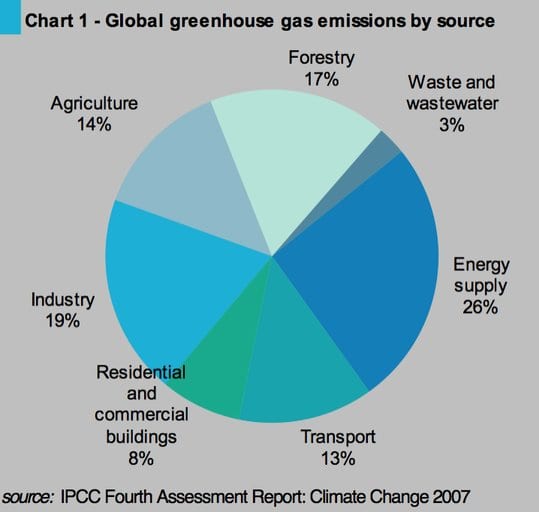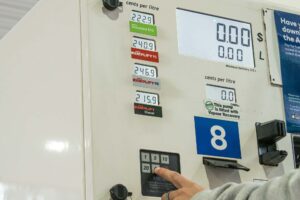The UN Climate Conference in December is important but will not be the final word on how we are dealing with climate change. Australian Ethical’s International Equities Portfolio Manager, Nathan Lim, explains
At the just concluded G7 meeting in Germany, seven of the largest economies in the world have agreed to the “decarbonisation of the global economy over the course of this century”. To this end, the group supported the upper range of the latest Intergovernmental Panel on Climate Change (IPCC) recommendation to reduce global greenhouse gas emissions by 40 to 70 percent by 2050 compared to 2010 levels.
This is a remarkable announcement and provides hope that the Conference of the Parties to the United Nations Framework Convention on Climate Change (COP21) will reach a global climate agreement in December.
Table 1 below summarises the individual country level pledges previously announced ahead of the G7 meeting. So what can we expect at COP21 given these developments?
Expectations for COP21
Table 1 highlights the subtlety and challenges of crafting a global agreement on emission reductions. Just looking at the base year for measurement and time frame selected by each country reflects their specific circumstances such that we have modest expectations for a universal emission reduction target. We believe nations will be left to contribute national targets with a low minimum bar likely sufficient to satisfy all parties. While not ideal for the environment, having some legislation to build further upon after the expiration of the second commitment period of the Kyoto Protocol that ends in 2020 is important.
An effective universal price on carbon also remains a distant proposition, but growing regional schemes is providing grass roots momentum. The European Emission Trading Scheme, California’s Cap-And-Trade program, China’s network of carbon trading trials and provincial carbon taxes in Canada are just some examples where this externality is being priced.
Carbon pollution needs a price signal and countries are delivering on it. We hold some hope that pricing will play a role in providing financial support to less developed nations ill prepared to deal with climate change.
This mechanism would be similar to the existing UN Clean Development Mechanism but with a more punitive carbon price.
What to expect after COP21
Even with a modest global agreement we believe there will be several positive trends to come out of COP21.
Coal-fired power generation the biggest loser
Coal-fired power generation will continue to face constant policy pressure regardless of the outcome of COP21. Reducing emissions intensity from the power sector is already well entrenched in most of the major global economies.
Not only does coal have a very high carbon footprint, it also emits high levels of sulfur oxide, nitrogen oxides, mercury, and particulate matter. As countries develop, the risks from increasing air pollution become more apparent and regulated. For example, China has already reached its “Cuyahoga River Fire” or “London Pea Soup” moment that is seeing it take action to diversify its power generation mix away from coal.
Moving beyond cars and trucks
In the transport sector, passenger vehicle and truck emission/mileage standards are well developed. The growing prevalence of turbochargers, stop-start engines, hybrids, full electric vehicles and compressed natural gas (CNG) engines is a testament to the underlying legislative pressures forcing vehicle manufacturers globally to cut fleet emissions.
Again, regardless of what happens at COP21 this trend will continue but we also expect policy to extend to aircrafts next. The US Environmental Protect Agency (EPA) has just ruled that aircraft emissions are a threat to human health as it increases the risk of climate change.
The EPA had issued a similar ruling for light vehicles and power generation before it issued new legislation curbing carbon emissions from these sources. The anticipated new emission rules for aircrafts from the EPA will put it in the mix with the EU and the International Civil Aviation Organisation (ICAO). ICAO is currently working on a global emission reduction strategy for the airline industry and is expected to release its framework in 2016. The EU already regulates aircraft emissions but suspended the rule until 2016 to allow ICAO time to complete its work.
The continued rise of renewables
Decarbonising the power sector has already started, and COP21 will not change this. We continue to believe that rooftop solar will be the main beneficiary as retail electricity prices continue to rise. To be clear, we believe the upward pressure on prices will not come from higher wholesale energy prices. Rather, prices will rise because of regulatory structures that allow utilities to pass on the cost of investments in transmission and distribution to consumers.
Globally, the “poles-and-wires” infrastructure is either insufficient or in desperate need of upgrading such that incremental investment will continue to put upward pressure on the delivered cost of electricity to consumers. This perversely has the potential to push more households towards self-generation and perhaps even off the grid entirely.
Energy efficiency will become more important
The most efficient watt is the one you do not use. This simple idea has manifested in power consumption essentially flat-lining in the developed world. We wrote about this previously here. Referring to Chart 1, Residential and Commercial Buildings are one of the worst sources of emission largely because of inefficient heating/cooling systems and poor lighting choices.
Even a weak outcome from COP21 will not detract from the simple economics that reveal energy efficiency is one of the cheapest ways to cut carbon pollution. We expect more energy efficiency mandates globally via more stringent building standards that promote intelligent low consumption lighting, HVAC upgrades and increased thermal insulation. Ideally, these standards would extend to existing structures where some of the worst examples of energy waste are occurring.
Natural gas will fulfil its role as a transition fuel supporting renewables development– look at South Australia
A rapid downshift in emissions levels without causing massive social dislocations can be achieved today by simply switching from coal to natural gas. As natural gas-fired generation is highly dispatchable it can efficiently deal with the inherent intermittency of wind and solar energy.
As more renewable energy is added to the grid, geographic diversification will naturally smooth out some of the intermittency thus allowing natural gas usage to decline gradually over time. Eventually, when affordable storage technology comes widely available, we can then progressively retire natural gas-fired generation.
This is not a theoretical construct but is happening today where renewable energy and natural gas coexist. As was recently reported on Reneweconomy, South Australia had a fire at its sole baseload coal generator that saw the entire state operate at least a whole day solely on wind, solar and natural gas.
We must emphasise that wind and solar contributed the majority of the state’s energy needs with natural gas infilling when needed. We estimate that wind and solar averaged 86% of the day’s energy needs with natural gas infilling the rest.
In fact, natural gas usage was contributing less than 7% of the state’s needs at some points during the day. With the continued redeployment of wind and solar energy, South Australia should be able to demonstrate that a low-emissions power system is possible today with the final step towards zero emissions tantalisingly close.
COP21 should be a watershed moment as new global agreement on emissions is drawn up to replace the Kyoto Protocol. The veracity of the agreement will undoubtedly please no one but despite any of its shortcoming, the road to a lower emissions intensive future is already well on its way.
In the near term, coal will keep losing share, more forms of transportation will be scrutinised for their emissions, buildings will become more energy efficient and renewable energy will grow and grow. Regardless of what transpires at COP21, Paris should deliver an earlier Christmas present if only to cement our collective conscience to confront the challenges of climate change.
Nathan Lim is a portfolio manager with Australian Ethical Investment.










